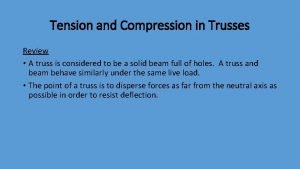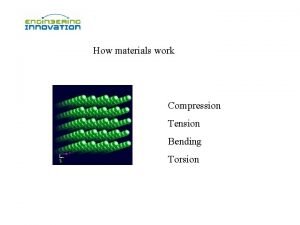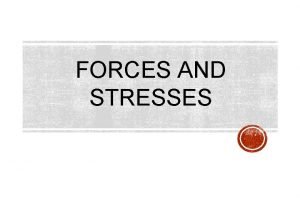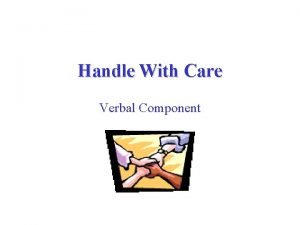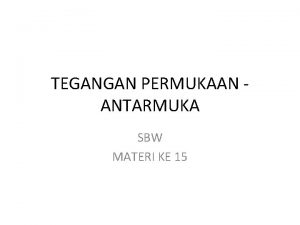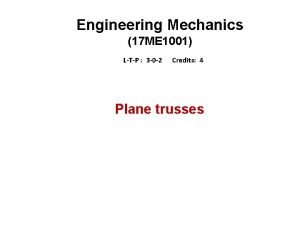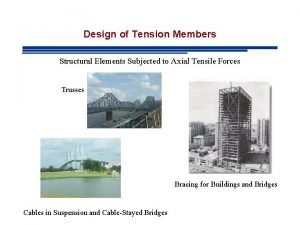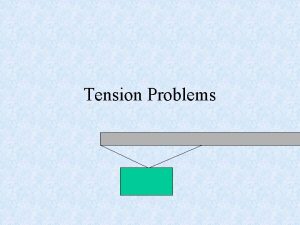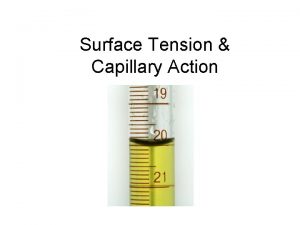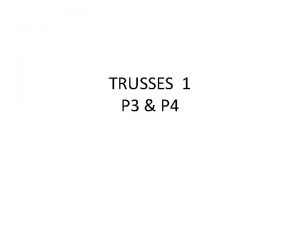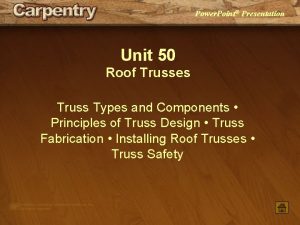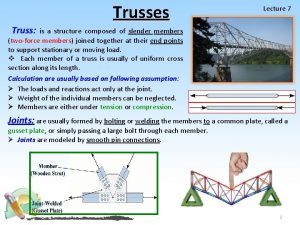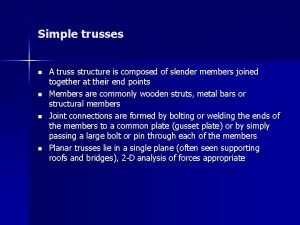Tension and Compression in Trusses Review A truss










- Slides: 10

Tension and Compression in Trusses Review • A truss is considered to be a solid beam full of holes. A truss and beam behave similarly under the same live load. • The point of a truss is to disperse forces as far from the neutral axis as possible in order to resist deflection.

Tension and Compression in Trusses • Review - Top-Loaded Truss • Has a live load acting on the top of the truss (roadway on top). • The area directly beneath the load is under compression and is called the “compression zone”. • Non-vertical members next to the compression members must be tension members. At each joint, the sum of the vertical (and horizontal) components of the member forces must be zero. • Therefore, for a top-loaded truss, non-vertical members beyond the compression zone must be in tension and compression, alternately distributed.

Tension and Compression in Trusses • Review - Bottom-loaded Truss • Has a live load is acting on the bottom of the truss (roadway on the bottom), • The area above the load is under tension and is called the “tension zone”. • Non-vertical members next to the tension members must be compression members. • Therefore, for a bottom-loaded truss, non-vertical members beyond the tension zone must also be in compression and tension, alternately distributed.

Tension and Compression in Trusses • You can mathematically analyze a truss with the “Method of Joints” • The method of joints states: • Each joint of the truss must be in equilibrium • For each joint, the net force in the x- and y-directions must equal zero.

Tension and Compression in Trusses • For a truss to be effective: • the sum of the forces in the x-direction must equal zero • the sum of the forces in the y-direction must equal zero • the moments of force must equal zero. • Your bridge is either top or bottom-loaded. There is no horizontal component of force, therefore ΣFx = 0 Pinned and roller joints

Tension and Compression in Trusses • To analyze a truss for static loads 1. Determine if the truss is statically determinate. Then you can use the static equilibrium equations to analyze the truss. • Use the equation: 2 J = M + 3 where J = number of joints, and M = number of members

Tension and Compression in Trusses 2. External Forces • Calculate the sum of the forces in the x-direction – remember to set the sum equal to zero. • Calculate the sum of the forces in the y-direction – remember to set the sum equal to zero.

Tension and Compression in Trusses 3. More External Forces • Moment – a moment of force is the product of a force and its distance from an axis, which causes rotation about that axis. • Sum the moments in the y-direction to solve for the unknown. Then substitute into the external forces equation to solve for all external forces. • Start with the sum of the moments about the first joint. • If the joint would rotate clockwise when the force is applied, the moment is negative. • If the joint would rotate counterclockwise when the force is applied, the moment is positive.

Tension and Compression in Trusses 4. Internal Forces • Start with the pinned joint where you know two external forces. Do not use moments when calculating internal forces – only external forces. • Draw a free-body diagram at that joint. • Always measure angles with respect to the positive x-axis. • Solve for the forces acting on each member in the truss. • Members in compression have negative internal forces. • Members in tension have positive internal forces. • Pinned and roller joints

Tension and Compression in Trusses – Analyzing your bridge • We will say that your bridge is vertically loaded with 100 N (about 22. 4 lbs) of force downward (-100 N). That means that the sum of the forces in the vertical direction must equal 100 N. ΣFy = 100, therefore Fy(joint 1) +Fy(final joint) = 100 • Start with the sum of the moments about the first joint. • ΣM(joint 1) = (100 N x the distance the force is from the joint, in meters) + (Fy on the opposing joint x distance from joint) = 0
